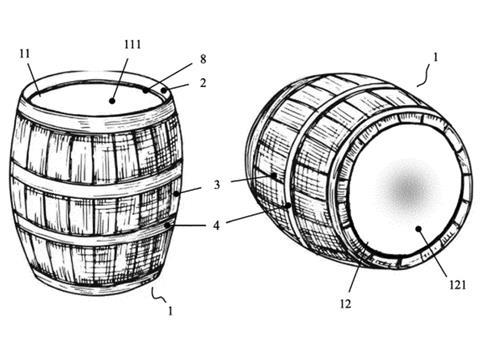Chris Hambley, patent attorney in the Advanced Engineering group at European intellectual property firm Withers & Rogers talks us through a novel container for wine, which was granted a patent in May 2024.

How and where wine is stored can affect its smell and taste. When exposed to too much oxygen, it could lose its brightness in terms of both colour and flavour, and cork taint or light damage can leave an unpleasant odour.
Over the years, refinements to containers for food and drink products have mainly been targeted at preserving the contents or improving transportation. For high-end drinks, such as wine and spirits, product design is potentially more important as customers may be willing to pay more for goods that have been produced or stored in containers that enhance flavour.
Wooden barrels have been used for centuries as containers for storing and transporting wine, due to the aroma and flavour imparted by tannins in the wood. To control the transmission of tannins to the wine, the internal surface of each barrel is treated by a heat source such as a brazier. However, heat treating of the lids, which close the ends of a barrel, can sometimes lead to deformations, which would inhibit sealing. Therefore, these lids are often made of untreated wood, which can lead to the unwanted transfer of compounds that could negatively affect the flavour or aroma of the wine.
To combat this flaw in traditional wine storage methods, a new container design is outlined in a European patent - EP4212448,- which was granted to Champagne Henri Giraud in May 2024. The patent protects a liquid container (1) with a cylindrical open frame (2) made of wooden staves (3). The staves (3) are heat treated on an inner surface (31) and joined together by at least one hoop (4). The container has closing parts (111, 121) to close the top and bottom ends of the open frame (2). These closing parts are made of a ceramic material.
The ceramic closing parts have a neutral effect on the wine, which allows for the aroma and flavour of the wine to be imparted solely from the wooden staves, which are heat-treated to control the transmission of organoleptic compounds. This new method of storage results in a noticeable improvement in the aroma and flavour of the wine. In addition, the ceramic closing parts are easier to clean and less prone to deformation than wooden alternatives, making them ideal for re-use.
This new patented design serves as a useful reminder that even in an ancient industry such as wine making, it is possible to refine the design and functionality of containers in order to improve the quality of product. In some cases, this could give food and drink producers a competitive edge and boost revenues. Furthermore, by obtaining patent protection, the owner will have exclusive rights to the invention and the benefits derived from it for a period of 20 years.
If you liked this story, you might also enjoy:
How are the top brands progressing on packaging sustainability?
Sustainable Innovation Report 2024: Current trends and future priorities
Reuse vs. single use – which is better for the environment?









No comments yet